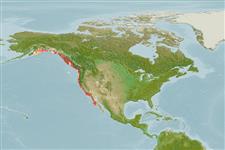>
Perciformes/Scorpaenoidei (Scorpionfishes) >
Sebastidae (Rockfishes, rockcods and thornyheads) > Sebastinae
Etymology: Sebastes: Greek, sebastes = august, venerable (Ref. 45335); auriculatus: From the Latin auriculatus, meaning 'eared' (Ref. 27436).
More on author: Girard.
Environment: milieu / climate zone / depth range / distribution range
Écologie
marin démersal; profondeur 0 - 128 m (Ref. 27437). Temperate; 62°N - 27°N, 155°W - 113°W
Eastern Pacific: Prince William Sound, Alaska to central Baja California, Mexico.
Length at first maturity / Taille / Poids / Âge
Maturity: Lm 31.0, range 26 - 38 cm
Max length : 56.0 cm TL mâle / non sexé; (Ref. 27437); âge max. reporté: 34 années (Ref. 56049)
Épines dorsales (Total): 13; Rayons mous dorsaux (Total): 12-15; Épines anales 3; Rayons mous anaux: 5 - 8; Vertèbres: 26 - 27. Head spines strong - nasal, preocular, postocular, tympanic, coronal (may be absent), parietal, and nuchal (may be absent) spines present, supraoculars absent (Ref. 27437). Interorbital space flat to barely convex; symphyseal knob weak or absent (Ref. 27437). Caudal fin rounded (Ref. 6885). Light brown, mottled with one or two shades of darker brown, vague dark bars dorsally, dark brown blotch on upper part of gill cover; fins and underside of throat and lower jaw pinkish (Ref. 27437). Branchiostegal rays: 7 (Ref. 36715).
A sedentary rockfish found in shallow water and bays (Ref. 2850), among sheltering weed-covered rocks or around pilings (Ref. 27436). Viviparous, with planktonic larvae and pelagic juveniles (Ref. 36715). Fin spines are sharp and mildly venomous and can cause annoying wounds (Ref. 27436). Small live specimens make excellent bait for large lingcod (Ref. 27436). Flesh is firm and tasty, but rarely found in markets (Ref. 26346).
Eschmeyer, W.N., E.S. Herald and H. Hammann, 1983. A field guide to Pacific coast fishes of North America. Boston (MA, USA): Houghton Mifflin Company. xii+336 p. (Ref. 2850)
Statut dans la liste rouge de l'IUCN (Ref. 130435)
Utilisations par l'homme
Pêcheries: intérêt commercial mineur; pêche sportive: oui; Aquarium: Aquariums publics; appât: occasionally
Plus d'informations
RéférencesAquacultureProfil d'aquacultureSouchesGénétiqueElectrophoresesHéritabilitéPathologiesTraitementNutrientsMass conversion
CollaborateursImagesStamps, Coins Misc.SonsCiguateraVitesseType de nageSurface branchialeOtolithesCerveauxVision
Outils
Articles particuliers
Télécharger en XML
Sources Internet
Estimates based on models
Preferred temperature (Ref.
123201): 8 - 12.8, mean 9.7 °C (based on 80 cells).
Phylogenetic diversity index (Ref.
82804): PD
50 = 0.5000 [Uniqueness, from 0.5 = low to 2.0 = high].
Bayesian length-weight: a=0.01000 (0.00499 - 0.02004), b=3.09 (2.92 - 3.26), in cm total length, based on LWR estimates for this Genus-body shape (Ref.
93245).
Niveau trophique (Ref.
69278): 4.0 ±0.62 se; based on food items.
Résilience (Ref.
120179): Faible, temps minimum de doublement de population : 4,5 à 14 années (tmax=34; tm=5).
Prior r = 0.21, 95% CL = 0.14 - 0.32, Based on 1 stock assessment.
Fishing Vulnerability (Ref.
59153): Moderate vulnerability (42 of 100).
Nutrients (Ref.
124155): Calcium = 23.4 [8.7, 72.9] mg/100g; Iron = 0.241 [0.100, 0.565] mg/100g; Protein = 18.2 [17.0, 19.3] %; Omega3 = 1.14 [0.47, 2.78] g/100g; Selenium = 31.1 [12.4, 94.1] μg/100g; VitaminA = 24.2 [7.7, 76.5] μg/100g; Zinc = 0.356 [0.189, 0.635] mg/100g (wet weight);
